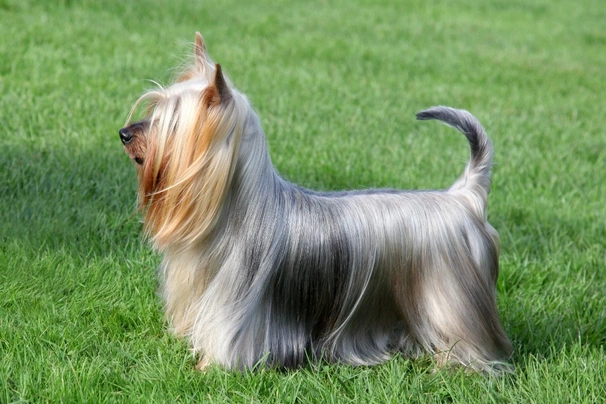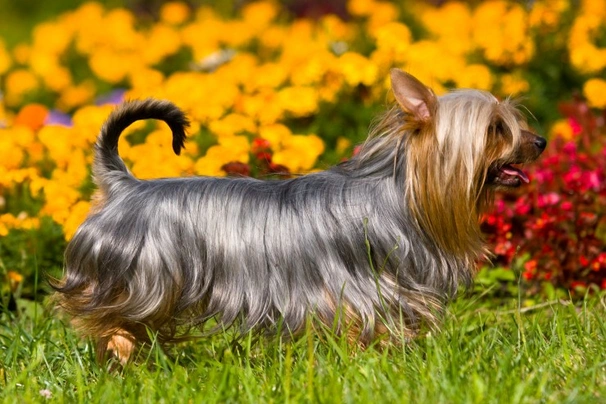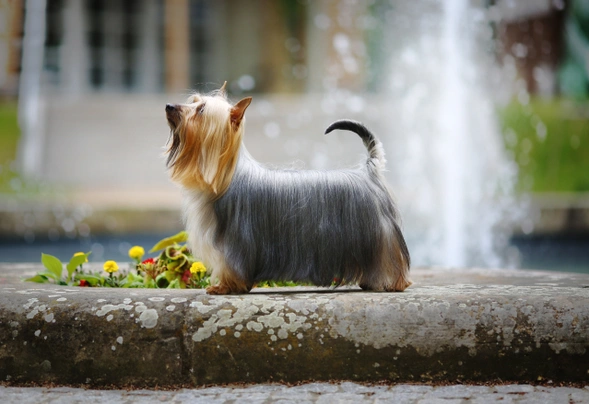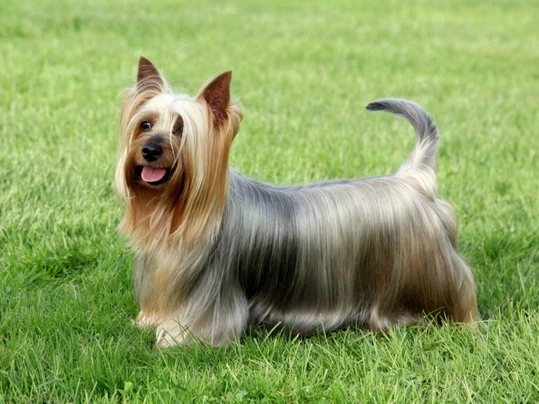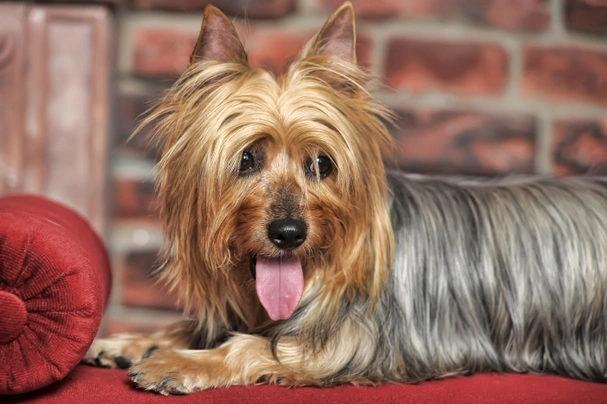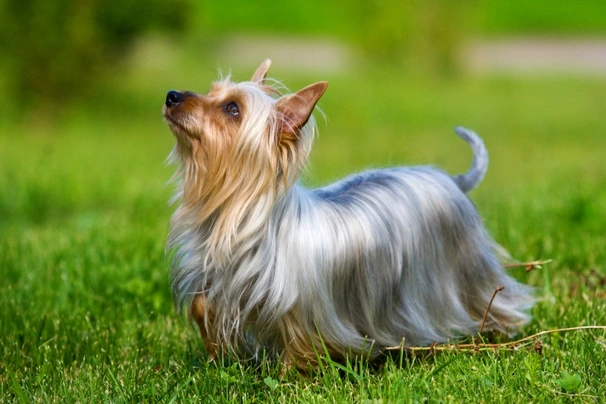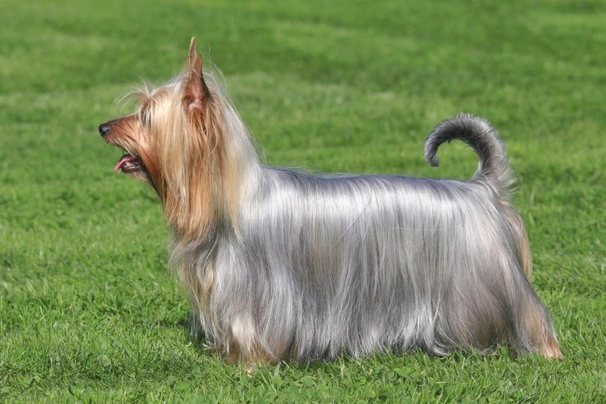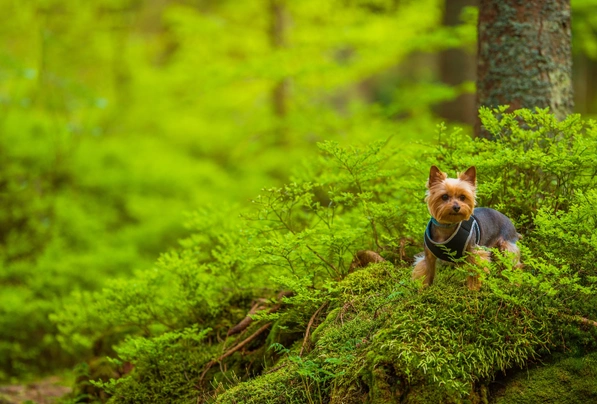Australian Silky Terrier
Pros
Cons
Introduction of the Australian Silky Terrier
Also known as the Sydney Silky these little dogs as their name suggests hail from Australia and over the years they have become a popular choice of companion dogs in many other countries of the world including here in the UK. The Australian Silky Terrier may be classed as a Toy breed but they are far from being purely a lap dog.
Australian Silky Terriers are independent friendly energetic little dogs that boast a tremendous amount of stamina. The breed is thought to have come about by crossing Australian with Yorkshire Terriers along with other terrier types over the years but this is hard to prove. With this said the Silky has retained a lot of the qualities that their cousins the Yorkie are known to have. However finding healthy well-bred Australia Silky puppies can prove challenging and they can be expensive with long waiting lists but the good news is the wait would be well worth it.
History of the Australian Silky Terrier
Although the actual origins of the Silky remain unknown it is thought that the breed was first developed during the late 1900’s when people randomly crossed many breeds which ended up producing the Australian Terrier. Early English immigrants to Australia had taken their dogs with them more especially small terrier-type breeds that did not take up too much space on sailing vessels.
These early colonials took their dogs with them to keep vermin under control and to watch over their livestock as well as their properties. As a result many English terrier type breeds were crossed together which produced what was then referred to as being broken or rough coated terriers. The terrier types that were taken over to Australia back in the day were breeds like the Skye Scottish Paisley Black & Tan as well as the Clydesdale Waterside Roseneath and Norwich terrier.
The first Broken Coated Terriers were exhibited at the Royal Melbourne Show in 1872 with two classes having been set in place one for dogs under 7 lbs and the other for terriers over 7 lbs in weight with the lighter terriers were called Broken Coated Toy Terriers. Several years later in 1888 show dogs were referred to as Broken Coated Blue Terriers. However blue and tan coated dogs were to become the “norm” over time and it is thought that it is at this stage in the history that the breed became known as being the “Australian Terrier”.
At the time there were 2 very distinct types with the first having a coarser wiry coat and the second having a much softer textured one. Successive breeding programmes resulted in the physical characteristics of each type being strengthened and more apparent. In Tasmania the Dandie Dinmont was introduced into the mix with an end goal being to produce dogs with softer coats while at the same time enhancing their top knots. At some time in history the Yorkshire Terrier was introduced into the breeding programme which it is thought was done to enhance a dog’s coat texture as well as its length.
The very first breed standard was established in Australia which was then updated in 1904 by the Victorian Silky and Yorkshire Club. Enthusiasts and breeders based in Sidney established the Sydney Silky Club before proceeding to develop a breed standard for dogs that were to become known as Sidney Silkies. In 1911 the Silky was finally recognised as being a unique breed and a few years later in 1934 crossbreeding was outlawed by the Kennel Control Council of Australia which in short meant that Silkies could not be mated to Yorkshire or Australian Terriers to keep the “breed” pure.
Today these little dogs are a favourite pet in many countries of the world and breeders based in Australia still receive requests from people far afield for Sydney Silkies. With this said the breed was officially recognised in 1959 when they were given their present name the Australian Silky Terrier and a definitive standard was set for the breed. However finding well-bred Silkies in the UK can prove challenging with waiting lists being long and puppies can often command lots of money.
Interesting facts about the breed
- Is the Australian Silky Terrier a vulnerable breed? No although less popular than the Yorkie the Silky has found a large fanbase in the UK
- It is thought that many terrier breeds were used to create the Australian Silky Terrier
- MacArthur Little was a big breed enthusiast who promoted Australian Silky Terriers throughout the world
- Traditionally an Australian Silky Terrier’s tail was always docked but since the law banning the procedure came into effect in 2007 tail docking is now illegal with the exception being for some working breeds and if a dog suffers from some sort of health issue that requires their tails to be docked. The procedure must be agreed and authorised before being performed by a qualified vet. Failure to have the correct documentation would result in heavy fines
Appearance of the Australian Silky Terrier
Height at the withers: Males 20 - 23 cm Females 19 - 20 cm
Average weight: Males 4.5 kg Females 3.5 kg.
The Australian Silky Terrier is a toy dog but as previously mentioned they are far from being a lap dog. They resemble their cousins the Yorkshire Terrier having similar coloured coats and being of a similar size. However these little dogs are quite different in many other ways. They are compact little dogs that always boast a well-groomed look about them.
Their heads are nicely proportioned in relation to the rest of their bodies always showing a strong terrier type trait with a silky top-knot and shiny black noses. Their eyes are quite small and oval shaped with an intelligent keen and always “ready” expression in them. Their ears are V-shaped and small being set high on a dog's head and always pricked adding to a dog's alert expression. Silkies don't have any long hair on their ears.
The Australian Silky Terrier boasts a strong jaw with a perfect scissor bite where their upper teeth neatly overlap their lower ones. Their necks are medium in length boasting a small crest and covered in silky hair. A dog's shoulders are well laid back and fine with straight front legs. Their body is quite long in relation to their overall height and these little dogs boast a nice level back whether they are relaxed or moving around. Chests are moderately deep and ribs well sprung.
These dogs may be small in stature but they have well developed thighs and strong back legs for their size. Their feet are very cat-like small and well-padded with tight toes and very dark or black nails. Tails are moderately long and covered in hair with a small amount of feathering on the underside.
When it comes to their coat the Australian Silky Terrier boasts a flat and fine one that's silky in texture naturally glossy and free flowing. These little dogs come in a variety of colours all of which are acceptable as a breed standard which are as follows:
- Blue & Tan
- Grey Blue & Tan
- Silver & Tan
- Silver Blue & Tan
Puppies are born with a very dark blue coat although to the novice eye they look black. The only tan markings to be found are on a puppy's feet above each of their eyes and on their underbodies which makes them look very similar to Yorkshire Terrier puppies. However their coats start to change colour at around 18 months old when an Australian Silky Terrier puppy's coat turns blue which is a process referred to as "breaking colour".
It is worth noting that the accepted breed colours for Kennel Club registration can differ from those set out in the breed standard which are as follows:
- A dog’s coat can be all shades of blue and tan with colours being rich and well-defined. Dogs with lighter blue coats must have dark blue roots and the blue on their tails must be very dark
Dogs must have a silver/blue or fawn top-knot and tan around the base of their ears muzzles and on the sides of their cheeks. Blue is found from the base of a dog’s skull to the tip of their tails and must run down their forelegs close to their knees and then right down a dog’s thighs to their hocks. A tan line runs down their stifles with the colour tan running from their knees and hocks to a dog’s toes and around their vents.
It is worth noting that puppies can have black colouring in their coats which is permissible under the Kennel Club breed standard. By the time puppies are 18 months old they should have a blue body colour which is free of any tan or any bronzing with the tan markings being well defined without any signs of smuttiness.
Gait/movement
When an Australian Silky Terrier moves they do so with a straight free and true gait showing no slackness in their shoulders or their elbows. They have a lot of drive in their hindquarters with lots of flexibility in their hocks and stifles.
Faults
The Kennel Club frowns on any exaggerations or departures from the breed standard and would judge the faults on how much they affect a dog's overall health and wellbeing as well as their ability to perform.
Males should have both testicles fully descended into their scrotums and it is worth noting that a dog can be a little lighter or heavier as well as slightly taller or shorter than set out in the Kennel Club breed standard which is only given as a guideline.
Temperament of the Australian Silky Terrier
These little dogs are very keen alert and terrier-like characters which means they like to be kept busy and active. As previously mentioned they are definitely not lap dogs and like to be kept busy as much as possible. Silkies are also extremely friendly and affectionate terriers by nature and they are quick to respond to people and any commands they are given bearing in mind that they would happily run off and give chase to anything that tries to run away from them.
Known to be independent by nature they are also extremely inquisitive. They boast having a lot of stamina which means for such a little dog they are more than capable of tiring an owner out. Having been bred to be a family pet and companion the Australian Silky Terrier fits the bill perfectly which is why they are fast becoming such a popular choice with people the world over.
Although these little dogs show affection to all members of a family they are known to form a special bond with one person. They are generally good around strangers and will tolerate being around people they don't know but that's all. They also need to be well socialised and trained from a young age for them to grow up to be confident well-rounded dogs. They may be small in stature but they are forceful little terriers which means they need to know who the alpha dog is in a household or they may become a little unruly and show a more dominant side to their natures which can be hard to manage and correct at later on.
Being intelligent little dogs Silkies are easy to train but they can pick up bad habits very easily too especially if they are not correctly handled. This includes excessive barking whenever they are left on their own in the house for any length of time.
Are they a good choice for first time owners?
The Australian Silky Terrier is the perfect choice for first time dog owners because they are so amenable and people-oriented loving nothing more than to please and to entertain their families.
What about prey drive?
Silkies are terriers by nature and will happily chase anything they spot in the distance or which tries to run away from them which they would do with glee. As such care should always be taken as to where and when a Silky can run off the lead more especially if there is wildlife and livestock close by.
What about playfulness?
Australian Silkies have a very playful side to their natures and love to entertain and be entertained. They are known to be a little mischievous when the mood takes them and being so clever they quickly understand how to please an owner and how to get their own way which although a lot of fun it can lead to them developing “small dog syndrome” making them harder to manage and live with.
What about adaptability?
Silkies are highly adaptable little terriers and providing they are given enough daily physical exercise combined with as much mental stimulation to prevent boredom from setting in they are just as happy living in an apartment in town as they would be living in a house in the country.
What about separation anxiety?
Australian Silkies form strong ties with their families and dogs are never very happy when they find themselves left on their own for longer periods of time. They are better suited to people who either work from home or in households where one person stays at home when everyone else is out so they are never alone for any length of time which could see a dog suffering from separation anxiety. This can lead to them being destructive around the home which is a dog's way of relieving any stress they are feeling and a way to keep themselves entertained which includes incessant barking which they are known to like anyway.
What about excessive barking?
Silkies are known to like the sound of their own voices a little too much which is something that needs to be gently nipped in the bud when a dog is still young being careful not to frighten them. However even with the best training it can be hard to convince a Silky that it is not necessary to bark at everything just for the sake of it.
Do Australian Silky Terriers like water?
Most Australian Silkies like swimming and will take to the water whenever they can more especially when the weather is hot. However if anyone who owns a dog that does not like water should never force them to go in because it would just end up scaring them. With this said care should always be taken when walking a Silky off the lead anywhere near more dangerous watercourses just in case a dog decides to leap in and then needs rescuing because they cannot get out of the water on their own.
Are Australian Silky Terriers good watchdogs?
Although small in stature Australian Silkies are always on the alert and because they have no idea of just how small they are they make great watchdogs ready to take on the world when they need to. However rarely would a Silky show any sort of aggression preferring to keep their distance stand their ground and bark.
Intelligence / Trainability of the Australian Silky Terrier
Australian Silkies are intelligent little dogs and much like their Yorkie cousins they have no idea of how small they really are. They love being with people and are always eager to please but they are terriers and do have a mind of their own. With this said their training must start early and it needs to be consistent. They respond well to positive reinforcement training but not any sort of harsh handling or correction which would not achieve positive results with these little dogs. Puppies must be well socialised from a young age and introduced to as many new things as possible for them to grow up to be outgoing well-rounded characters.
Like all puppies Silkies are incredibly cute when young and it is all too easy to spoil them when they first arrive in new homes. As soon as a puppy is nicely settled owners must start out as they mean to go on by laying down ground rules and boundaries so that a puppy understands what is expected of them. It helps establish a pecking order and who the alpha dog is in the household. The first commands a puppy should be taught are as follows:
- Come
- Sit
- Stay
- Heel
- Quiet
- Leave it
- Down
- Bed
Children and other
These little dogs generally get on very well with children if they have been bought up with them. However they do not like to be messed with or fussed over which could result in them becoming a little "snappy" towards the kids. They are also good around other dogs and family cats providing they have been well socialised from a young age and they’ve grown up with them.
However when it comes to small pets it is best not to let a Silky near them no matter how well socialised and obedient a dog might be because they are after all terriers and in it's in their natures to chase and kill any small prey.
Health of the Australian Silky Terrier
The average life expectancy of an Australian Silky Terrier is between 11 to 14 years when properly cared for and fed an appropriate good quality diet to suit their ages.
Silkies are known to be hardy and robust little terriers but like so many other pure breeds they are known to suffer from certain hereditary health issues which are worth knowing about if you are going to share your home with one of these lively terriers. The disorders most common to the breed are as follows:
- Progressive retinal atrophy (PRA) - annual screening through the BVA/KC eye scheme
- Dermatitis
- Portosystemic shunt
- Patellar luxation
- Skin cancer
- Cataract
- Urolithiasis
- Breathing issues
- Weakness in the upper and lower jaw
- Dental issues
It is worth noting that the UK Kennel Club breed average COI for the Australian Silky Terrier is 6.0%.
What about vaccinations?
Silky puppies would have been given their initial vaccinations before being sold but it is up to their new owners to make sure they have their follow-up shots in a timely manner with the vaccination schedule for puppies being as follows:
- 10 -12 weeks old bearing in mind that a puppy would not have full protection straight away but would be fully protected 2 weeks after they have had their second vaccination
There has been a lot of discussion about the need for dogs to have boosters. As such it's best to talk to a vet before making a final decision on whether a dog should continue to have annual vaccinations which are known as boosters.
What about spaying and neutering?
A lot of vets these days recommend waiting until dogs are slightly older before spaying and neutering them which means they are more mature before undergoing the procedures. As such they advise neutering males and spaying females when they are between the ages of 6 to 9 months old and sometimes even when a dog is 12 months old.
Other vets recommend spaying and neutering dogs when they are 6 months old but never any earlier unless for medical reasons. With this said many breeds are different and it is always advisable to discuss things with a vet and then follow their advice on when a dog should be spayed or neutered.
What about obesity problems?
Like other breeds some Silkies gain weight after they have been spayed or neutered and it's important to keep an eye on a dog's waistline just in case they do. If a dog starts to put on weight it's important to adjust their daily calorie intake and to up the amount of exercise they are given. Older dogs too are more prone to gaining weight and again it's essential they be fed and exercised accordingly because obesity can shorten a dog's life by several years. The reason being that it puts a lot of extra strain on a dog's internal organs including the heart which could prove fatal.
What about allergies?
Australian Silkies are prone to suffering from dermatitis and allergies and it's important for a dog to see a vet sooner rather than later if one flares up. Allergies can be notoriously hard to clear up and finding the triggers can be challenging. With this said a vet would be able to make a dog with an allergy more comfortable while they try to find out the triggers which could include the following:
- Certain dog foods that contain high levels of grains and other cereal-type fillers
- Airborne pollens
- Dust mites
- Environment
- Flea and tick bites
- Chemicals found in everyday household cleaning products
Participating in health schemes
All responsible Australian Silky Terrier breeders would ensure that their stud dogs are tested for known hereditary and congenital health issues known to affect the breed by using the following schemes:
- Progressive retinal atrophy – dogs should be screened annually through the BVA/KC eye scheme
What about breed specific breeding restrictions?
Apart from the standard breeding restrictions that are in place for all Kennel Club registered breeds there are no other breed specific breeding restrictions in place for the Australian Silky Terrier.
What about Assured Breeder Requirements?
Currently there are no Kennel Club Assured Breeders requirements in place for the Australian Silky Terrier.
Caring for the Australian Silky Terrier
As with any other breed Australian Silky Terriers need to be groomed on a regular basis to make sure their coats and skin are kept in top condition. They also need to be given regular daily exercise to ensure they remain fit and not put on too much weight. On top of this Silkies need to be fed good quality food that meets all their nutritional needs throughout their lives.
Caring for an Australian Silky Terrier puppy
Australian Silky puppies are boisterous and full of life which means it's essential for homes and gardens to be puppy-proofed well in advance of their arrival. A responsible breeder would have well socialised their puppies which always leads to more outgoing confident and friendly dogs right from the word go. With this said any puppy is going to feel vulnerable when they leave their mother and littermates which must be taken into account. The longer a puppy can remain with their mother the better although it should never be for too long either.
It's best to pick a puppy up when people are going to be around for the first week or so which is the time needed for a puppy to settle in. Puppy-proofing the home and garden means putting away any tools and other implements that a boisterous puppy might injure themselves on. Electric wires and cables must be put out of their reach because puppies love chewing on things. Toxic plants should be removed from flowerbeds and the home too.
Puppies need to sleep a lot to grow and develop as they should which means setting up a quiet area that's not too out of the way means they can retreat to it when they want to nap and it's important not to disturb them when they are sleeping. It's also a good idea to keep "playtime" nice and calm inside the house and to have a more active "playtime" outside in the garden which means puppies quickly learn to be less boisterous when they are inside.
The documentation a breeder provides for a puppy must have all the details of their worming date and the product used as well as the information relating to their microchip. It is essential for puppies to be wormed again keeping to a schedule which is as follows:
- Puppies should be wormed at 6 months old
- They need to be wormed again when they are 8 months old
- Puppies should be wormed when they are 10 months old
- They need to be wormed when they are 12 months old
Things you'll need for your puppy
There are certain items that new owners need to already have in the home prior to bringing a new puppy home. It's often a good idea to restrict how much space a puppy plays in more especially when you can't keep an eye on what they get up to bearing in mind that puppies are often quite boisterous which means investing in puppy gates or a large enough playpen that allows a puppy the room to express themselves while keeping them safe too. The items needed are therefore as follows:
- Good quality puppy or baby gates to fit on doors
- A good well-made playpen that's large enough for a puppy to play in so they can really express themselves as puppies like to do
- Lots of well-made toys which must include good quality chews suitable for puppies to gnaw on bearing in mind that a puppy will start teething anything from when they are 3 to 8 months old
- Good quality feed and water bowls which ideally should be ceramic rather than plastic or metal
- A grooming glove
- A slicker brush or soft bristle brush
- Dog specific toothpaste and a toothbrush
- Scissors with rounded ends
- Nail clippers
- Puppy shampoo and conditioner which must be specifically formulated for use on dogs
- A well-made dog collar or harness
- A couple of strong dog leads
- A well-made dog bed that's not too small or too big
- A well-made dog crate for use in the car and in the home that's large enough for a puppy to move around in
- Baby blankets to put in your puppy's crate and in their beds for when they want to nap or go to sleep at night
Keeping the noise down
All puppies are sensitive to noise including Australian Silky puppies. It's important to keep the noise levels down when a new puppy arrives in the home. TVs and music should not be played too loud which could end up stressing a small puppy out which could result in dogs being withdrawn timid and shy.
Keeping vet appointments
As previously mentioned Australian Silky Terrier puppies would have been given their first vaccinations by the breeders but they must have their follow up shots which is up to their new owners to organise. The vaccination schedule for puppies is as follows:
- 10 -12 weeks old bearing in mind that a puppy would not have full protection straight away but would only be fully protected 2 weeks after they have had their second vaccination
When it comes to boosters it's best to discuss these with a vet because there is a lot of debate about whether a dog really needs them after a certain time. However if a dog ever needed to go into kennels their vaccinations would need to be fully up to date.
What about older Australian Silky Terriers when they reach their senior years?
Older Silkies need lots of special care because as they reach their golden years they are more at risk of developing certain health concerns. Physically a dog's muzzle may start to go grey but there will be other noticeable changes too which includes the following:
- Coats become coarser
- A loss of muscle tone
- They can either become overweight or underweight
- They have reduced strength and stamina
- Older dogs have difficulty regulating their body temperature
- They often develop arthritis
- Immune systems do not work as efficiently as they once did which means dogs are more susceptible to infections
- Older dogs change mentally too which means their response time tends to be slower as such they develop the following:
- They respond less to external stimuli due to impaired vision or hearing
- They tend to be a little pickier about their food
- They have a lower pain threshold
- Become intolerant of any change
- Often an older dog can feel disorientated
Living with an Australian Silky Terrier in their golden years means taking on a few more responsibilities but these are easily managed and should include looking at their diet the amount of exercise they are given how often their dog beds need changing and keeping an eye on the condition of their teeth.
Older Australian Silkies must be fed a good quality diet that meets their needs at this stage of their lives all the while keeping a close eye on a dog's weight. A rough feeding guide for older dogs is as follows bearing in mind they should be fed highly digestible food that does not contain any additives:
- Protein content should be anything from 14 – 21%
- Fat content should be less than 10%
- Fibre content should be less than 4%
- Calcium content should be 0.5 – 0.8%
- Phosphorous content should be 0.4 – 0.7%
- Sodium content should be 0.2 – 0.4%
Older Australian Silkies don't need the same amount of daily exercise as a younger dog but they still need the right amount of physical activity to maintain muscle tone and to prevent a dog from putting on too much weight. All dogs need access to fresh clean water and this is especially true of older dogs when they reach their golden years because they are more at risk of developing kidney disorders.
Grooming of the Australian Silky Terrier
A Silkie’s hair is not that different to a person's hair and as such their coats need a daily brush to keep things tidy and tangle-free. It's important to start grooming puppies as early as possible always making sure the experience is a good one so that dogs look forward to the one-to-one attention they are given when being brushed.
When it comes to bathing these little dogs don't need to be bathed that often unless it is absolutely necessary. It's important for dogs to be thoroughly dried after a bath to prevent them from feeling the cold and catching a chill. It’s also a good idea to have dogs professionally groomed a few times a year especially in the Spring and then again in the Autumn when dogs tend to shed more hair.
Exercise of the Australian Silky Terrier
As previously mentioned Silkies may be small in stature but they boast a tremendous amount of energy. As such they are definitely not thought of as lap dogs or couch potatoes. They need to be given the right amount of daily exercise and this includes playing lots of interactive games which Silkies love. It also ensures they burn off any excess calories which reduces the risk of them becoming overweight.
Feeding of the Australian Silky Terrier
Silkies are not known to be finicky or fussy eaters but this does not mean they can be fed lower quality food because it will not contain all the right vitamins minerals and other nutrients that dogs need to stay healthy. As such it's important to feed a Silky a good quality well-balanced diet making sure it suits the different stages of a dog's life.
If you have decided to get a puppy from a breeder they would provide you with a feeding schedule and it's important to stick to it for the first few weeks after bringing a puppy home. You can change their diet when the time is right but this needs to be done very gradually and carefully over a few weeks to make sure puppies don't suffer any tummy upsets. If they do get the runs it’s best to put them back on their original diet before discussing things with the vet.
It's also important for puppies to be fed at least 3 to 4 times a day to begin with but you can start feeding them the same amount of food twice a day when they are around 4 months old always keeping an eye on things to make sure a young dog can cope with the change in their feeding routine.
Feeding guide for an Australian Silky Terrier puppy
Puppies need to be fed a highly nutritious good quality diet for them to develop and grow as they should. As a rough guide an Australian Silky puppy can be fed the following amounts every day making sure their meals are evenly spread out throughout the day and it's best to feed them 3 or 4 times a day to reduce the risk of their blood/sugar levels don’t drop too low:
- 2 months old - 64g to 78g depending on a puppy's build
- 3 months old - 69g to 88g depending on a puppy's build
- 4 months old - 69g to 92g depending on a puppy's build
- 5 months old - 69g to 92g depending on a puppy's build
- 6 months old - 62g to 84g depending on a puppy's build
- 7 months old - 55g to 75g depending on a puppy's build
- 8 months old - 54g to 66g depending on a puppy's build
- 9 months old - 54g to 66g depending on a puppy's build
Once a Yorkshire Terrier is 10 months old they can be fed an adult food and given 2 or 3 meals a day evenly spread out throughout the day which makes sure a puppy's blood sugar levels don't drop too low.
Feeding guide for an adult Australian Silky Terrier
Once fully mature an adult Australian Silky Terrier should be fed a good quality diet to ensure their continued good health. As a rough guide an adult dog can be fed the following amounts every day:
- Dogs weighing 3.5 kg can be fed 63 g to 72 g a day
- Dogs weighing 4.5 kg can be fed 78 g to 89 g a day
Australian Silky Terrier price
If you are looking to buy an Australian Silky Terrier you would need to pay anything from £300 to over £450 for a well-bred pedigree puppy. The cost of insuring a male 3-year-old Australian Silky Terrier in northern England would be £19.95 a month for basic cover but for a lifetime policy this would set you back £42.56 a month (quote as of April 2018). When insurance companies calculate pet insurance they factor in a few things and this includes where you live in the UK and a dog's age and whether a dog has been spayed or neutered among other things.
When it comes to food costs you need to buy the best quality food whether wet or dry to feed your dog throughout their lives making sure it suits the different stages of their lives. This would set you back between £30 - £40 a month. On top of this you would need to factor in veterinary costs if you want to share your home with an Australian Silky Terrier which includes their initial vaccinations their boosters the cost of neutering or spaying your dog when the time is right and then their annual health check visits all of which could quickly add up to over a £800 a year.
As a rough guide the average cost to keep and care for an Australian Silky Terrier would be between £60 to £90 a month depending on the level of insurance cover you opt to buy for your dog but this does not include the initial cost of buying a well-bred Kennel Club registered pedigree Australian Silky Terrier puppy.
Buying advice
When visiting and buying any puppy or dog there are many important things to consider and questions to ask of the breeder/seller. You can read our generic puppy/dog advice here which includes making sure you see the puppy with its mother and to verify that the dog has been wormed and microchipped.
Although not as popular as Yorkies Australian Silkies have a fanbase in the UK although finding well-bred Kennel Club registered puppies can prove challenging which means they can often command lots of money. As such with Australian Silkies there is specific advice questions and protocols to follow when buying a puppy which are as follows:
- Beware of online scams and how to avoid them. You may see online and other adverts by scammers showing images of beautiful Australian Silkiesfor sale at very low prices. However the sellers ask buyers for money up front before agreeing to deliver a puppy to a new home. Potential buyers should never buy a puppy unseen and should never pay a deposit or any other money online to a seller. You should always visit the pet at the sellers home to confirm they are genuine and make a note of their address.
- Australian Silkies although not as popular as the Yorkie is finding a big fanbase in the UK. As such some amateur breeders/people breed from a dam far too often so they can make a quick profit without caring for the welfare of the puppies their dam or the breed in general. Under Kennel Club rules a dam can only produce 4 litters and she must be between a certain age to do so. Anyone wishing to buy an Australian Silky puppy should think very carefully about who they purchase their puppy from and should always ask to see the relevant paperwork pertaining to a puppy's lineage their vaccinations and their microchipping.
- Prospective owners should be very careful when considering buying an extra small puppy because all too often they suffer from very serious health issues and no responsible breeder would purposefully breed dogs so they are too small which includes breathing problems conformation and dental issues.
- Traditionally an Australian Silky’s tail was always docked but since the law banning the procedure came into effect in 2007 tail docking is now illegal with the exception being for some working breeds and if a dog suffers from some sort of health issue that requires their tails to be docked. The procedure must be agreed and authorised before being performed by a qualified vet failure to have the right documentation would result in heavy fines.
